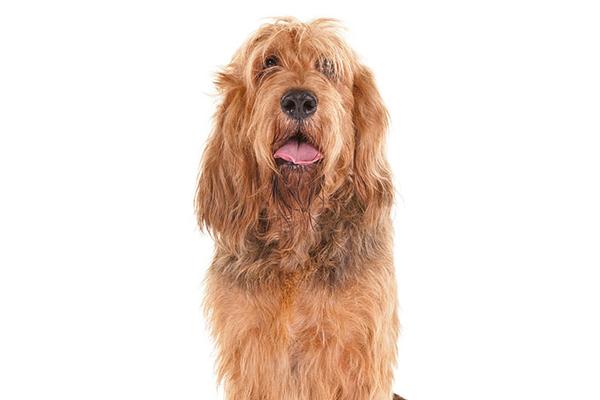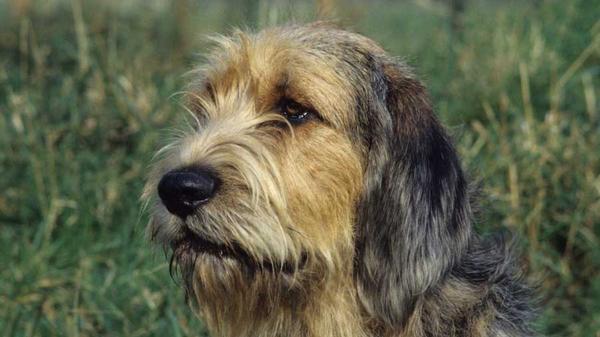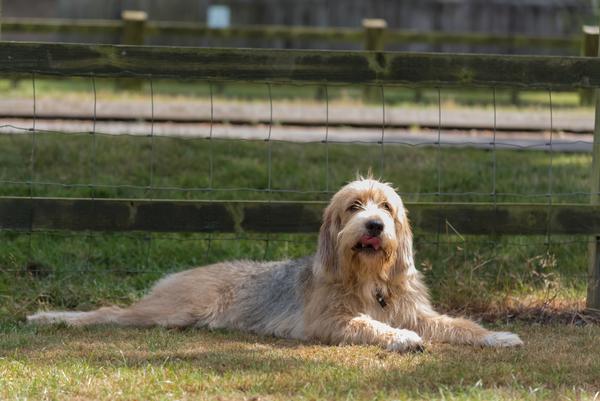Otterhound
also known as Otter Dog

 History
History
The Otterhound is a large and rugged breed that has a rich history and a unique set of characteristics. They are known for their shaggy, thick coat and their keen sense of smell, which makes them an excellent hunter of otters and other aquatic game.
The Otterhound is thought to have originated in the 12th century in England, where they were developed by British nobles as an otter hunting dog. They were bred by crossing several different breeds, including the Bloodhound, the Terrier, the English Water Spaniel, and the French Griffon, to create a dog with the strength, stamina, and keen sense of smell needed to hunt otters.
The breed's name, Otterhound, is a reference to its original purpose as an otter hunting dog. The "Otter" part of the name refers to the breed's ability to hunt otters, while the "Hound" part of the name is a reference to the breed's origins as a hunting dog.
Historically, the Otterhound was a very popular breed among British nobles, who used them for otter hunting. However, in 1978, the British government banned otter hunting, which led to a decline in the population of Otterhounds.
The Otterhound was officially recognized as a separate breed by the American Kennel Club (AKC) in 1909 and the United Kennel Club (UKC) in 1911. The Canadian Kennel Club (CKC) recognized the breed in 1913.
The Otterhound Club of America was formed in 1960, to preserve and protect the breed, and to promote its versatility as a companion, obedience and agility dog. They are considered a rare breed with a limited population, it is listed as a "vulnerable native breed" by the Kennel Club of Great Britain.
Breed Information
Is Otterhound a purebred?
Purebred
What were Otterhounds originally used for?
hunting otters, scenting
How Long Do Otterhounds Live? What is average life expectancy for an Otterhound? How long can Otterhounds live?
10-12 years
The average Otterhound lifespan is somewhere between 10-12 years, provided they aren't beset by any exceptional health issues or injuries.
Otterhound Height & Weight
How big is a full grown Otterhound?

| Height | ||||
|---|---|---|---|---|
| Average | 6 months | 12 months | 18 months | |
| Male | 24-27 inches (61 - 68.6 cm) | 10.5 inches (26.7 cm) | 15.5 inches (39.4 cm) | 22.5 inches (57.2 cm) |
| Female | 24-26 inches (61 - 66 cm) | 10.0 inches (25.4 cm) | 14.5 inches (36.8 cm) | 21.0 inches (53.3 cm) |
| Weight | ||||
|---|---|---|---|---|
| Average | 6 months | 12 months | 18 months | |
| Male | 90-110 pounds (41 - 50 kg) | 40.0 pounds (18 kg) | 65.0 pounds (29 kg) | 92.5 pounds (42 kg) |
| Female | 70-90 pounds (32 - 41 kg) | 35.0 pounds (16 kg) | 55.0 pounds (25 kg) | 72.5 pounds (33 kg) |
Do Otterhounds get fat easily?
![]()
![]()
![]()
![]()
![]()
The Otterhound is a breed that has an average risk of becoming obese. Daily walks and a balanced diet of quality dry dog food can help maintain a healthy weight. An active lifestyle and monitoring weight regularly is recommended.
Are Otterhounds Hypoallergenic?
No
Unfortunately, the Otterhound is not hypoallergenic, making it not a good choice for a dog lover who suffers from pet allergies.
What is an Otterhound personality? What are Otterhound dogs best known for?
Amiable
Outright
Tempered
Boisterous
Are Otterhounds heavy shedders? How Much Does an Otterhound Shed?
![]()
![]()
![]()
![]()
![]()
Otterhound dogs are heavy shedders, they will lose a significant amount of hair each year. To decrease the amount of shedding, you can regularly brush your Otterhound. This will remove loose hair and keep his coat growing in the same direction.
What is the watchdog ability of an Otterhound dog?
![]()
![]()
![]()
![]()
![]()
Otterhounds are not the best watchdogs. If you want a guard dog, the Otterhound is not the breed for you. They will 'watch' everything - but that's usually as far as they go.
Breed History
Where do Otterhounds come from?
England
What are Otterhounds descended from?
griffon nivernais
What organizations or kennel clubs recognize/register the Otterhound breed?
American Kennel Club
Australian National Kennel Council
Canadian Kennel Club
Continental Kennel Club
Federation Cynologique Internationale
Kennel Club of Great Britain
National Kennel Club
New Zealand Kennel Club
United Kennel Club
When were Otterhounds first bred? How old is the Otterhound breed?
1300s
What Breed Group is an Otterhound?
Hound (AKC:1909)
Scenthound (UKC)

Otterhound Appearance
What color are Otterhound eyes?
Hazel
Brown
What color can Otterhound nose be naturally?
Black
Brown
What color can Otterhound coat be naturally?
Cream
Brown
Black
White
Fawn
Blue
Gray
How long is an Otterhounds coat?
![]()
![]()
![]()
![]()
![]()
The coat of an Otterhound falls in the medium length category.
How Dense Is The Otterhound Coat?
![]()
![]()
![]()
![]()
![]()
What is the texture of the hair of an Otterhound?
Wiry
How many puppies can an Otterhound have in a litter? How many puppies can an Otterhound have in her first litter?
10-12 puppies per pregnancy
An Otterhound can have a litter of 10-12 puppies on average. However, it's worth noting that the size of the litters can vary greatly. Factors that can influence litter size include the health of the mother, breeding history, and genetics.
![]()
![]()
![]()
![]()
![]()
Otterhound dogs generally adapt well to changes in lifestyle and different living environments, but it is considered as an average level of adaptability compared to other breeds.

Otterhound Health Issues
Do Otterhounds have a lot of health problems?
![]()
![]()
![]()
![]()
![]()
The Otterhound is a breed of dog that is known to have a higher frequency of health issues compared to other breeds. These issues can range from minor to serious, and regular check-ups with a veterinarian are essential in order to identify and address any potential problems as early as possible.
What are the major health concerns to be aware of when owning an Otterhound?
Hip Dysplasia
Congenital Heart Defect
What are the less significant issues to keep in mind when it comes to Otterhounds?
Elbow Dysplasia
Thrombopathia
What are the occasional tests recommended for Otterhound breed?
Hip
Elbow
Blood
Blood Test
X-Rays
Physical Examination

Otterhound Needs and Activities
Do Otterhounds have a lot of energy?
![]()
![]()
![]()
![]()
![]()
Otterhounds are high-energy dogs, thus an active lifestyle suits them well.
Do Otterhounds need socialization? How social are Otterhounds?
![]()
![]()
![]()
![]()
![]()
Otterhounds have average social needs compared to other breeds. They are known to be less active and independent than other breeds, and they are content with spending time alone and with their human family.
How much exercise should Otterhounds get?
![]()
![]()
![]()
![]()
![]()
The Otterhound needs a high level of physical activity to maintain a healthy lifestyle. They also make great companions for people who lead an active lifestyle and enjoy running, hiking or other outdoor activities. These breeds are not suitable for people with sedentary lifestyle or those who live in small apartments
How much sleep should an Otterhound have? Do Otterhounds sleep a lot?
![]()
![]()
![]()
![]()
![]()
Otterhounds are active dogs that don't require as much sleep as other breeds. However, they still need enough sleep to stay healthy.
Does an Otterhound drool a lot?
![]()
![]()
![]()
![]()
![]()
The Otterhound is a breed of dog that is characterized by its minimal drooling, making it an ideal choice for people who dislike drool marks on their clothing.
How much does it bark?
![]()
![]()
![]()
![]()
![]()
Otterhounds tend to bark moderately, they bark when necessary, such as to alert their owner or to communicate something. They may also bark due to certain triggers like fear, alarm, boredom, greeting, separation anxiety and compulsive barking.
Do Otterhounds exhibit aggressive behavior to safeguard their home and territory? Do they possess a natural tendency to guard?
![]()
![]()
![]()
![]()
![]()
Otterhound dogs are not known for their protective nature and may not be the best choice as guard dogs. They do not have a strong drive to defend their territory and may not be inclined to provide protection.
Are Otterhounds mouthy?
![]()
![]()
![]()
![]()
![]()
What is the likelihood of an Otterhound running away? Do they have a tendency to explore or wander frequently?
![]()
![]()
![]()
![]()
![]()
Do Otterhound dogs have a high prey drive?
![]()
![]()
![]()
![]()
![]()
What do Otterhounds enjoy doing? How do I keep my Otterhound busy?
Fishing, Go to Beach, Swim
What is the energy level of an Otterhound? How much energy does an Otterhound have?
Medium
Otterhounds are medium-energy dogs and typically enjoy socializing and playing casual or even sustained games of chase with other dogs. They may also have occasional periods of barking or racing around the house.
![]()
![]()
![]()
![]()
![]()
How far should an Otterhound walk each week? How many miles should an Otterhound walk every week?
7 miles / week
There's really no limit to how far you walk your dog as long as they're comfortable. For Otterhound, it's at least 7 miles / week. Just remember to build distance and stamina gradually over time.
How much an Otterhound should exercise a day? How much activity does an Otterhound need?
45 minutes
In general most Otterhounds usually need at least 45 minutes of exercise daily. This can be spread across the day and include all sorts of high-energy activities, like walking, running and playing.
What level of grooming should be provided for an Otterhound?
![]()
![]()
![]()
![]()
![]()
The Otterhound is a breed of dog that requires a significant amount of grooming. They will also require regular trims, and a professional groomer's help is often necessary to keep their coat in good condition. They may also need regular baths to maintain their coat and skin.
How often should you brush an Otterhound?
Weekly
Otterhound should be brushed at least once a week. Of course you can give them more frequent brushes if you find that they are still shedding a lot
What are the most commonly used brushing tools for Otterhounds?
Slicker Brush
Comb
Clipper
Nail Clipper
Costs
How many cups of food does an Otterhound eat?
3 cups
For an average 90-110 pound (41 - 50 kg) Otterhound feed 3 cups daily. But, keep in mind, the amount you feed is going to be dependent on the quality of the food you are feeding.
How Much Does an Otterhound Cost Daily?
$2.10 - $2.70 / day
The average cost of an Otterhound is somewhere $2.10 - $2.70 per day.
How Much Does an Otterhound Cost Per Month?
$55 - $73 / month
The average per month expenses of an Otterhound is between $55 - $73. This makes an average of $660 - $876 per year. It will be on the higher side when the dog is still small because it will need more frequent visits to the vet, shots.
Otterhound Characteristic
How intelligent is an Otterhound?
![]()
![]()
![]()
![]()
![]()
Otterhounds has average obedience intelligence. But, they're also independent thinkers. The Otterhound is a breed with an exceptionally high IQ and may get into mischief if left to their own devices.
How sensitive is an Otterhound dog?
![]()
![]()
![]()
![]()
![]()
Otterhound dogs are a less sensitive breed known for their adaptability and resilience. They tend to be less affected by new environments, people and noises. They can make great companions for families or individuals looking for a balanced and less sensitive pet that are not as demanding as highly sensitive breeds.
Are Otterhound dogs affectionate?
![]()
![]()
![]()
![]()
![]()
Do Otterhound do well in apartments? Are Otterhounds good indoor dogs?
![]()
![]()
![]()
![]()
![]()
The Otterhound is not an apartment-friendly dog breed. This dog breed is best in a home with a large, fenced-in yard. They are not suited for apartment life and can become destructive due to pent up energy from being in a small space.
Are Otterhounds good with kids? Are Otterhounds good around children?
![]()
![]()
![]()
![]()
![]()
Otterhounds are kid-friendly dogs. They are good with children and excellent dogs with children if they are socialized and trained at a young age.
Are Otterhounds good for elderly?
![]()
![]()
![]()
![]()
![]()
Are Otterhounds good with cats? How friendly Otterhounds are toward cats?
![]()
![]()
![]()
![]()
![]()
Otterhounds are an average cat friendly dog. They do well with cats, even more if raised together from puppyhood,
Do Otterhound dogs get along with other dogs? Are Otterhounds OK with other dogs?
![]()
![]()
![]()
![]()
![]()
Otterhounds are average friendly towards other dogs. If they are raised with other dogs, they are likely to get along with them. And, if they are socialized properly from a young age, they will usually be great with other dogs.
How do Otterhound dogs interact with other pets? Are they considered pet-friendly?
![]()
![]()
![]()
![]()
![]()
Are Otterhounds friendly with strangers?
![]()
![]()
![]()
![]()
![]()
Otterhounds are below average friendly around strangers. Keen of eye and sharp of tongue, most Otterhounds are very quick to announce strangers at the door. Once the visitor comes in, some Otterhounds will be friendly and outgoing. But many others have the standoffish or suspicious towards strangers.
Do Otterhounds like to play? Are Otterhounds playful?
![]()
![]()
![]()
![]()
![]()
Otterhounds are known to be highly playful dog. So if you're not up for all that, think about adopting a slightly older Otterhound for a mellower experience.
Are Otterhound easily trained?
![]()
![]()
![]()
![]()
![]()
Otterhound dogs are known for their ease of training and ability to learn quickly, making them a popular choice for pet owners and trainers alike.
 Pros & Cons
Pros & Cons
Pros
- Boat Dog
The Otterhound breed tends to like the water and being on boats. - Affectionate
Otterhounds are affectionate dogs that bond well with their owners. - Good with children
Otterhounds are good with children and make great family pets.
Cons
- High energy
Otterhounds are high energy dogs that require a lot of exercise and mental stimulation. Without enough exercise, they can become bored and destructive. - Not Hypoallergenic
While beloved by many, Otterhounds may not be appropriate for those with allergies due to the possibility of allergic reactions. - Shedding
Otterhounds are known for shedding a significant amount of hair. - Not suitable for office environment
Otterhounds are not generally considered to be office-friendly dogs. - Not Apartment Friendly
Apartment living may not provide enough space for a Otterhound dog. - Prone to certain health issues
Otterhounds are prone to certain health issues such as hip dysplasia and bloat.